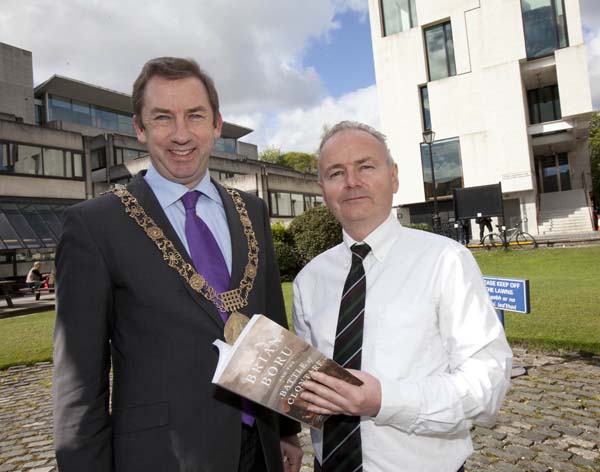Truth of the Battle of Clontarf Investigated at Conference
Posted on: 14 April 2014
A grudge rebellion or the medieval equivalent of the 1916 Rising? The world’s leading authorities on the Battle of Clontarf gathered in Trinity College Dublin recently in a bid to establish the truth of what really happened at the battle as part of a major international conference to mark the 1000th anniversary of the conflict and the death of Brian Boru.
There are few more emblematic dates in Irish history than that of the Battle of Clontarf, fought on Good Friday, 1014, when the high-king Brian Boru lost his life in the hour of victory against his Scandinavian and Irish foes. Traditional interpretations remember the battle as the medieval equivalent of 1916 with Brian as the martyr hero who led his people to victory over their would-be heathen conquerors on Good Friday. But more recent interpretations have favoured the view that the battle was little more than the culmination of a rebellion against Brian, the king of Munster, by the insubordinate king of Leinster and his Dublin associates.
Entitled Clontarf 1014-2014, the 16th Medieval Dublin Symposium organised by Trinity’s Department of History in partnership with Dublin City Council, brought together for the first time all the world’s leading authorities on the subject. The conference aimed to establish the truth of what really happened at Clontarf for a twenty-first century audience and to re-evaluate the role of Brian Boru in the light of the latest cutting-edge research including a reinvestigation of Brian’s ancestry to see where he fits into the DNA of the nation. It also highlighted recent research on the subject of the high-kingship of Ireland and of the role of the Vikings in medieval Ireland. The conference took place on Friday April 11th and Saturday April 12th in Trinity’s Edmund Burke Theatre.

Lord Mayor of Dublin Oisin Quinn and conference organiser Dr Seán Duffy, Associate Professor of Medieval History, Trinity.
A new website featuring interactive maps of the battle developed by postgraduate medieval historians in Trinity and the University’s Centre for High Performance Computing was also launched at the conference (http://dh.tcd.ie/clontarf/). Designed as an educational resource for the public to enrich their understanding of this important historical battle as well as everyday life in Viking-Age Ireland, the website features interactive maps charting Viking raids and settlement development, Brian Boru’s military campaigns, and what happened on Good Friday, 23 April 1014.
Conference organiser Dr Seán Duffy, Associate Professor of Medieval History in Trinity, commented: “The truth of the Battle of Clontarf is that it was no Leinster v. Munster interprovincial grudge match. If it was, it couldn’t be classed as a victory for Brian Boru, since he was killed there. The only way Clontarf could be considered a victory is if he gave his life confronting a much more menacing enemy than the king of Leinster: in this way, the high-king’s followers could reluctantly accept his loss as the price that had to be paid for what he had averted on that momentous day – a full-scale Scandinavian invasion of Ireland.”
“Brian Boru the man and the myth are right at the core of the Irish imagination. The emblem of the nation – displayed on everything from our coinage and the presidential standard to a pint of Guinness and on display in Trinity College – is the Brian Boru harp. Perhaps President Higgins will remind Queen Elizabeth that she too is a descendant of Brian Boru. Via James VI she is descended from Robert the Bruce, whose grandmother was granddaughter of Strongbow and Aoife MacMurrough, whose great-great-great grandmother was Brian’s great-great-great granddaughter. It is time that the real Brian, his real achievements and legacy are properly understood and interpreted for a modern audience.”
Trinity has a unique connection to Brian Boru, being the home of the so-called Brian Boru’s Harp whose image is the national symbol of Ireland. Although the harp has no known link to Brian and is considerably later in date, Trinity does in fact house the only artefact surviving today which we can definitively state the high-king saw and perhaps touched – the world-famous Book of Armagh with its inscription marking his visit to the primatial city in 1005 in which he styled himself Imperator Scotorum, “Emperor of the Gaels”.
Trinity also houses the largest collection of medieval manuscript sources for the Battle of Clontarf including the famous Cogadh Gáedhel re Gallaibh (The War of the Irish with the Foreigners) which, more than anything else, created the later mythical image of Brian Boru. These artefacts are on public display in a major new exhibition in Trinity’s Long Room entitled Clontarf 1014: Brian Boru and the Battle for Dublin, which will run until the end of 2014.
A full conference programme and registration details are available at: https://www.tcd.ie/history/clontarf/
Media Coverage:
- TheJournal.ie, April 11th, 2014, History experts descend on Trinity College to discover the truth about the Battle of Clontarf
- RTE, Radio 1, Mooney Show, April 10th, 2014
- Irish Times, April 10th, 2014, What did Brian Boru ever do for us?
- The Irish Times, April 11th, 2014, The long Good Friday: ‘Nobody could recognise even his own son, so covered were they in blood’
- The Irish Times, April 11th, 2014, Three kings and a queen
- The Evening Herald, April 2nd, 2014, The Myth of Brian Boru
Media Contact:
Fiona Tyrrell, Press Officer for the Faculty of Arts, Humanities and Social Sciences, Trinity College Dublin | tyrrellf@tcd.ie | + 353 1 8964337
